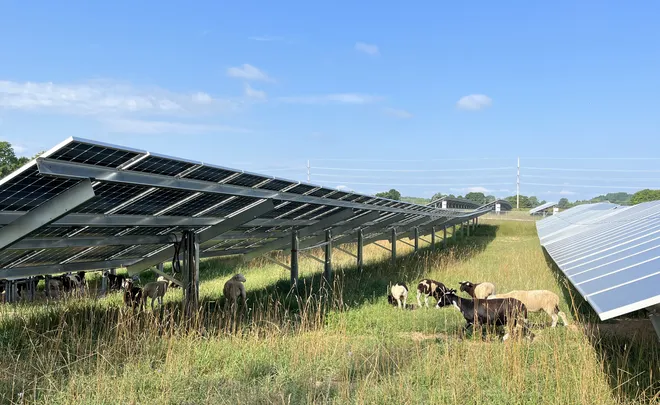Advocates Say Agriculture And Solar Power Can Help Each Other
time:2023-09-14 10:11:52 Views:0 author:Jinan Freakin Power Ltd.
Along busy Michigan Highway 72 in Traverse City, rows of huge solar panels gleam in the sun. In the shade underneath them is a flock of sheep. This is “solar grazing,” where livestock are placed around solar arrays to keep vegetation around the panels in check. The renewable company Heritage Sustainable Energy first put panels at the site in 2017. At the time, the array seemed big, and it’s grown in the years since, now measuring 30 acres. Heritage sells the electricity to Traverse City Light and Power. Still, it’s small compared with other arrays that have gone up around the state in recent years.
“Now there are solar arrays 150 times bigger than this. 150 megawatts,” Heritage Operations Manager Bart Hautala said. “So you figure 6 acres per megawatt — it's a 900-acre solar array.” It’s the third summer sheep have grazed around the M-72 site, and they seem to be comfortably at home. “They eat and there's a lot of it," Hautala said. "Like, I don't know where all this food is coming from. They won't eat the flowers, but they like the weeds.”

Solar power is a central part of Michigan’s plan to transition to renewable energy. As more projects go in, some solar companies and farmers are trying to work together to use land in ways that will benefit everyone involved. Solar grazing is part of the field of agrivoltaics, when farming and renewable energy projects work together to use land for energy and agriculture. Hautola said hosting 30 sheep on the array is a win-win: Sheep eat the grass, which prevents the foliage from shading the panels. “It’s a multiuse land now,” he said. “Before, it was just farmland and then after that it was just a solar array, but now it's a multipurpose use. It's environmentally friendly. We're helping out a farmer. He’s got more space to put more sheep, as opposed to just doing it on his own property and having limited space.”
Michigan State University Extension’s Charles Gould is familiar with the concerns and questions around solar grazing. He first got involved with agrivoltaics about a decade ago, when farmers began asking him for advice on solar company lease agreements. Since then, he’s delved into the dynamics of local governance, farming and solar power. Gould said many farmers have come to see solar lease agreements as a sort of retirement package, and some consequently bristle at local efforts to restrict solar development, seeing them as a threat to their chances at financial stability. “It evolved to: This is a takings issue,” he said. Farmers were asking, “‘How does a township have the right to tell me how to use my land?’” Of course, farmers are far from united on the issue. Others don’t like the idea of working with solar companies or leasing their land for renewables. Gould agrees that other areas should be considered for solar projects before farmland, like brownfields, rights-of-way and warehouse roofs. But, he said, solar can help farmers keep their land in the family. If planned correctly and if regulations allow, that land could be used for crops, pollinator habitat or grazing. And solar can also help offset energy costs for things like grain drying or milking parlors. As the state pursues its renewable energy goals, companies will continue to approach communities with these plans, according to MSU. To help local governments tackle solar planning and zoning questions, Gould and others created a guide, which includes templates for wind and solar zoning ordinances and steps on how to plan for various situations. “Really, if we want to be successful at this, we need to back up and think ahead of time before that solar project is on board,” Gould said. “Bring all the partners together, have them all sit down and figure out what that's going to look like.”




